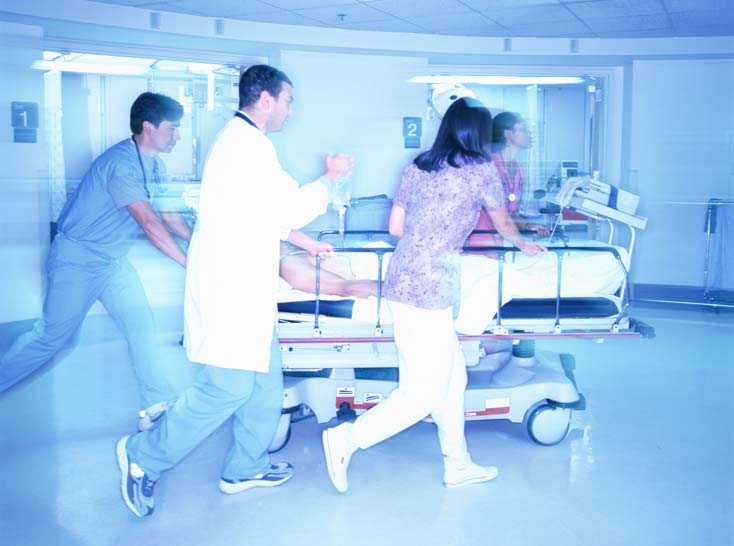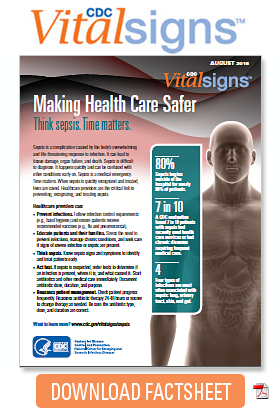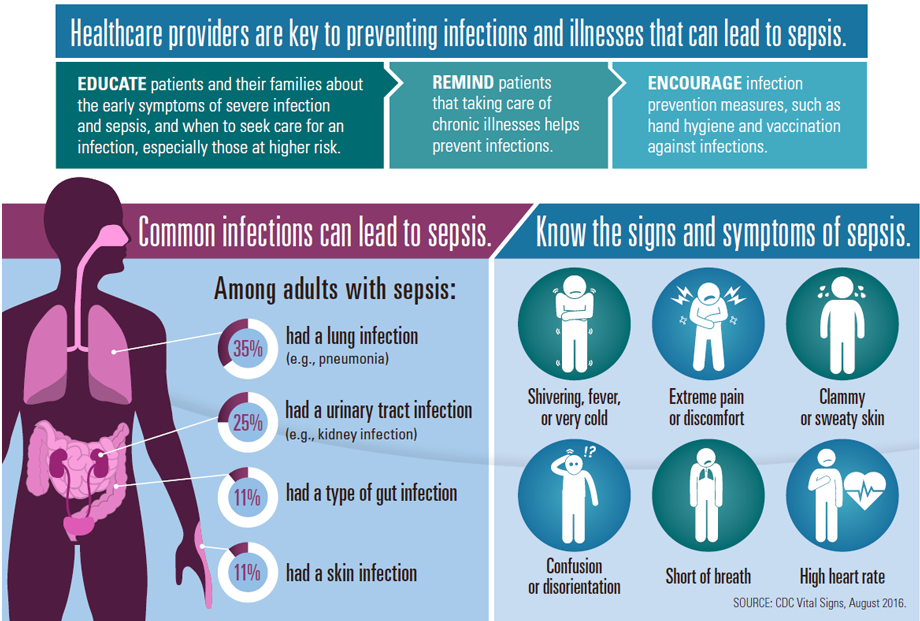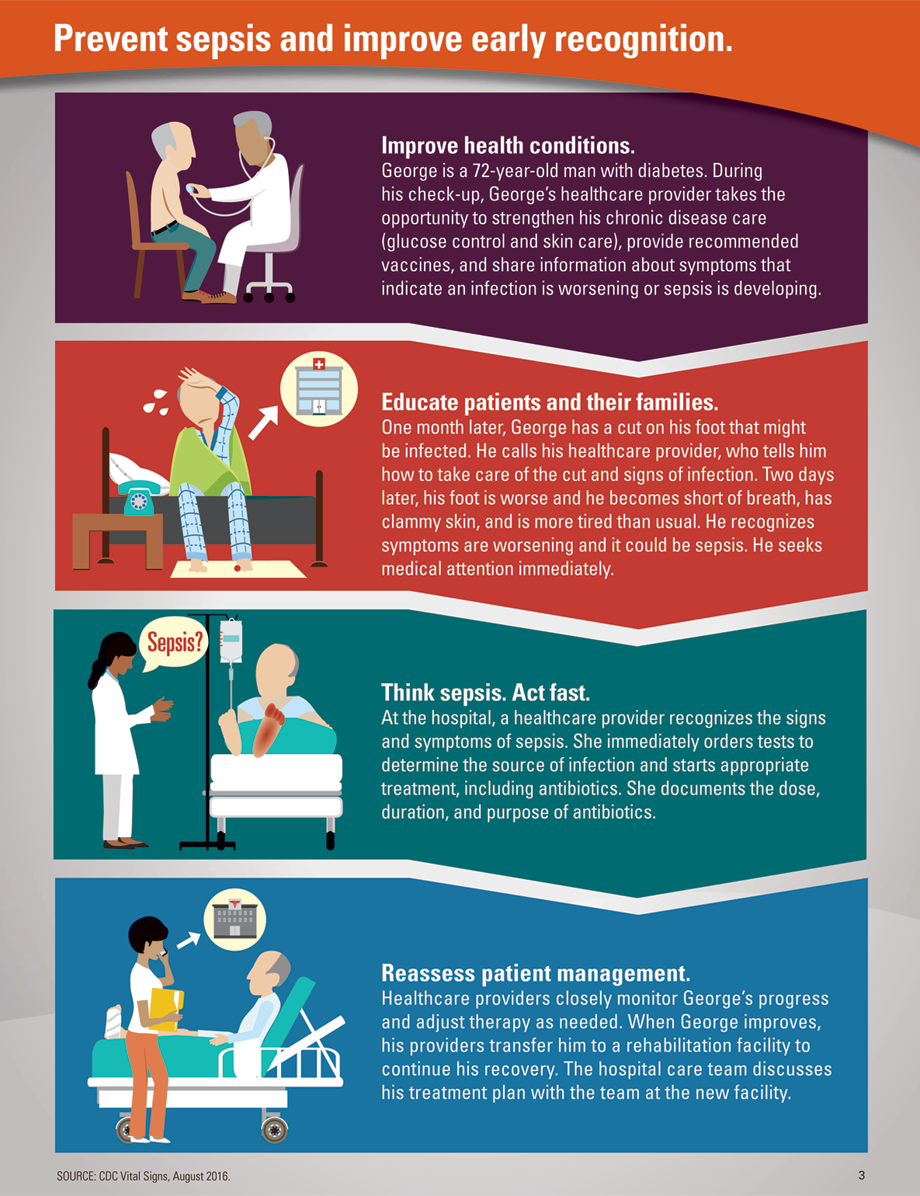Making Health Care Safer
Think sepsis. Time matters.
On This Page
Overview
Sepsis is a complication caused by the body’s overwhelming and life-threatening response to infection. It can lead to tissue damage, organ failure, and death. Sepsis is difficult to diagnose. It happens quickly and can be confused with other conditions early on. Sepsis is a medical emergency. Time matters. When sepsis is quickly recognized and treated, lives are saved. Healthcare providers are the critical link to preventing, recognizing, and treating sepsis.
Healthcare providers can:
- Prevent infections. Follow infection control requirements (e.g., hand hygiene) and ensure patients receive recommended vaccines (e.g., flu and pneumococcal).
- Educate patients and their families. Stress the need to prevent infections, manage chronic conditions, and seek care if signs of severe infection or sepsis are present.
- Think sepsis. Know sepsis signs and symptoms to identify and treat patients early.
- Act fast. If sepsis is suspected, order tests to determine if an infection is present, where it is, and what caused it. Start antibiotics and other medical care immediately. Document antibiotic dose, duration, and purpose.
- Reassess patient management. Check patient progress frequently. Reassess antibiotic therapy 24-48 hours or sooner to change therapy as needed. Be sure the antibiotic type, dose, and duration are correct.

Sepsis begins outside of the hospital for nearly 80% of patients.
A CDC evaluation found 7 in 10 patients with sepsis had recently used health care services or had chronic diseases requiring frequent medical care.
Four types of infections are most often associated with sepsis: lung, urinary tract, skin, and gut.
Problem
Sepsis is deadly when it’s not quickly recognized and treated.
Certain people with an infection are more likely to get sepsis.
- CDC evaluation found more than 90% of adults and 70% of children who developed sepsis had a health condition that may have put them at risk.
- Sepsis occurs most often in people 65 years or older or younger than 1 year, with weakened immune systems, or with chronic medical conditions (e.g., diabetes).
- While less common, even healthy infants, children, and adults can develop sepsis from an infection, especially when not treated properly.
Certain infections and germs lead to sepsis most often.*
- Four types of infections are often associated with sepsis: lung, urinary tract, skin, and gut.
- Common germs that can cause sepsis are Staphylococcus aureus, Escherichia coli (E. coli), and some types of Streptococcus.
*Among patients in the evaluation with an identified source of infection; however, infectious source cannot be identified in many patients.
Infographic
What Can Be Done
The Federal government is
- Working with partners to promote and align public health efforts, including: infection prevention, vaccinations, chronic disease management, appropriate antibiotic use, and sepsis prevention and early recognition.
- Investigating causes of sepsis to identify new prevention strategies and at-risk populations.
- Supporting development of new sepsis tests and treatments.
- Developing more accurate tracking methods to evaluate progress in preventing and treating patients with sepsis.
Healthcare providers can
- Prevent infections. Follow infection control requirements (e.g., hand hygiene) and ensure patients receive recommended vaccines (e.g., flu and pneumococcal).
- Educate patients and their families. Stress the need to prevent infections, manage chronic conditions, and seek care if signs of severe infection or sepsis are present.
- Think sepsis. Know sepsis signs and symptoms to identify and treat patients early.
- Act fast. If sepsis is suspected, order tests to determine if an infection is present, where it is, and what caused it. Start antibiotics and other medical care immediately. Document antibiotic dose, duration, and purpose.
- Reassess patient management. Check patient progress frequently. Reassess antibiotic therapy 24-48 hours or sooner to change therapy as needed. Be sure the antibiotic type, dose, and duration are correct.
Health care facility CEOs/administrators can
- Make infection control a priority. Ensure a strong link between infection control and prevention, sepsis early recognition, and appropriate antibiotic use programs.
- Train healthcare providers and front-line staff to quickly recognize and treat sepsis.
- Collaborate with health departments and other health care facilities within your area to improve infection control.
State and local health departments can
- Promote sepsis prevention and early recognition, vaccination, chronic disease management, and infection prevention in health care facilities and community settings.
- Review actions other states and organizations have taken to improve sepsis early recognition and treatment: http://go.usa.gov/xjxnz.
Patients and their families can
- Learn sepsis signs and symptoms. Know if you are at higher risk. If sepsis is suspected, get immediate medical attention. Ask, “Could it be sepsis?”
- Talk to a healthcare provider about managing chronic conditions and getting vaccines.
- Practice good hygiene, such as handwashing.
Issue Details
Related Pages
- Vital Signs Issue details: Making Health Care Safer, Think sepsis. Time matters. Morbidity and Mortality Weekly Report (MMWR)
- Digital Press Kit: Saving Patients from Sepsis
- Vital Signs – Think sepsis. Time matters. [PODCAST – 1:15 minutes]
- Vital Signs – Think sepsis. Time matters. [PSA – 0:60 seconds]
- CDC’s Sepsis Website
- CDC’s Safe Healthcare Blog
- CDC Healthcare-associated Infections (HAI)
- CDC Get Smart Programs: Know when antibiotics work
- CDC Antibiotic / Antimicrobial Resistance
- CDC Chronic Disease Prevention and Health Promotion
- CDC Vaccines & Immunizations
Science Behind the Issue
- Page last reviewed: August 23, 2016
- Page last updated: August 23, 2016
- Content source:
- National Center for Emerging and Zoonotic Infectious Diseases
- Page maintained by: Office of the Associate Director for Communications (OADC)


 ShareCompartir
ShareCompartir


